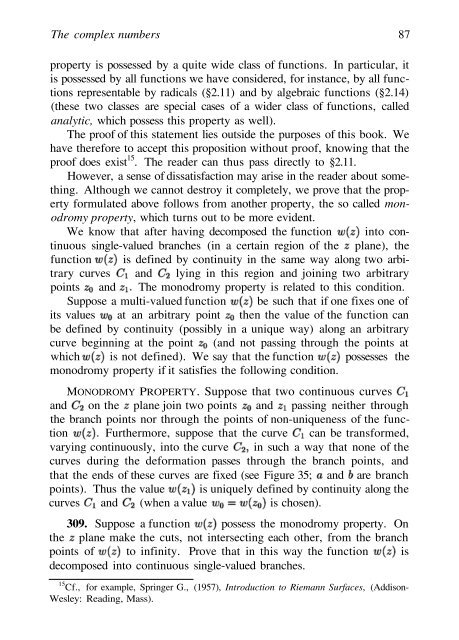Abel's theorem in problems and solutions - School of Mathematics
Abel's theorem in problems and solutions - School of Mathematics
Abel's theorem in problems and solutions - School of Mathematics
You also want an ePaper? Increase the reach of your titles
YUMPU automatically turns print PDFs into web optimized ePapers that Google loves.
The complex numbers 87<br />
property is possessed by a quite wide class <strong>of</strong> functions. In particular, it<br />
is possessed by all functions we have considered, for <strong>in</strong>stance, by all functions<br />
representable by radicals (§2.11) <strong>and</strong> by algebraic functions (§2.14)<br />
(these two classes are special cases <strong>of</strong> a wider class <strong>of</strong> functions, called<br />
analytic, which possess this property as well).<br />
The pro<strong>of</strong> <strong>of</strong> this statement lies outside the purposes <strong>of</strong> this book. We<br />
have therefore to accept this proposition without pro<strong>of</strong>, know<strong>in</strong>g that the<br />
pro<strong>of</strong> does exist 15 . The reader can thus pass directly to §2.11.<br />
However, a sense <strong>of</strong> dissatisfaction may arise <strong>in</strong> the reader about someth<strong>in</strong>g.<br />
Although we cannot destroy it completely, we prove that the property<br />
formulated above follows from another property, the so called monodromy<br />
property, which turns out to be more evident.<br />
We know that after hav<strong>in</strong>g decomposed the function <strong>in</strong>to cont<strong>in</strong>uous<br />
s<strong>in</strong>gle-valued branches (<strong>in</strong> a certa<strong>in</strong> region <strong>of</strong> the plane), the<br />
function is def<strong>in</strong>ed by cont<strong>in</strong>uity <strong>in</strong> the same way along two arbitrary<br />
curves <strong>and</strong> ly<strong>in</strong>g <strong>in</strong> this region <strong>and</strong> jo<strong>in</strong><strong>in</strong>g two arbitrary<br />
po<strong>in</strong>ts <strong>and</strong> The monodromy property is related to this condition.<br />
Suppose a multi-valued function be such that if one fixes one <strong>of</strong><br />
its values at an arbitrary po<strong>in</strong>t then the value <strong>of</strong> the function can<br />
be def<strong>in</strong>ed by cont<strong>in</strong>uity (possibly <strong>in</strong> a unique way) along an arbitrary<br />
curve beg<strong>in</strong>n<strong>in</strong>g at the po<strong>in</strong>t (<strong>and</strong> not pass<strong>in</strong>g through the po<strong>in</strong>ts at<br />
which is not def<strong>in</strong>ed). We say that the function possesses the<br />
monodromy property if it satisfies the follow<strong>in</strong>g condition.<br />
MONODROMY PROPERTY. Suppose that two cont<strong>in</strong>uous curves<br />
<strong>and</strong> on the plane jo<strong>in</strong> two po<strong>in</strong>ts <strong>and</strong> pass<strong>in</strong>g neither through<br />
the branch po<strong>in</strong>ts nor through the po<strong>in</strong>ts <strong>of</strong> non-uniqueness <strong>of</strong> the function<br />
Furthermore, suppose that the curve can be transformed,<br />
vary<strong>in</strong>g cont<strong>in</strong>uously, <strong>in</strong>to the curve <strong>in</strong> such a way that none <strong>of</strong> the<br />
curves dur<strong>in</strong>g the deformation passes through the branch po<strong>in</strong>ts, <strong>and</strong><br />
that the ends <strong>of</strong> these curves are fixed (see Figure 35; <strong>and</strong> are branch<br />
po<strong>in</strong>ts). Thus the value is uniquely def<strong>in</strong>ed by cont<strong>in</strong>uity along the<br />
curves <strong>and</strong> (when a value is chosen).<br />
309. Suppose a function possess the monodromy property. On<br />
the plane make the cuts, not <strong>in</strong>tersect<strong>in</strong>g each other, from the branch<br />
po<strong>in</strong>ts <strong>of</strong> to <strong>in</strong>f<strong>in</strong>ity. Prove that <strong>in</strong> this way the function is<br />
decomposed <strong>in</strong>to cont<strong>in</strong>uous s<strong>in</strong>gle-valued branches.<br />
15 Cf., for example, Spr<strong>in</strong>ger G., (1957), Introduction to Riemann Surfaces, (Addison-<br />
Wesley: Read<strong>in</strong>g, Mass).

















